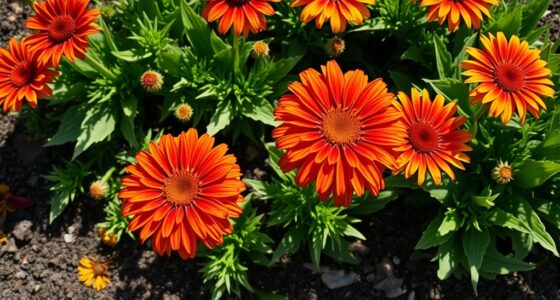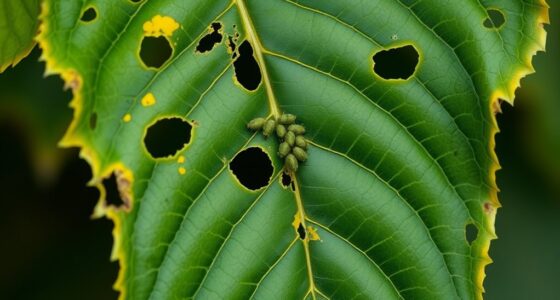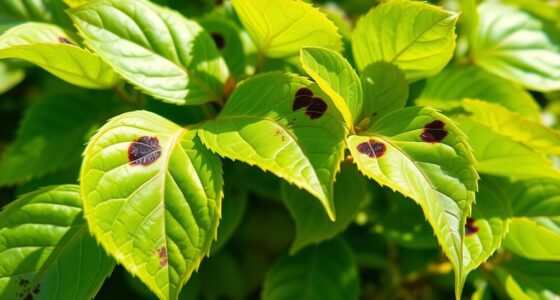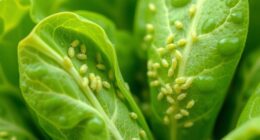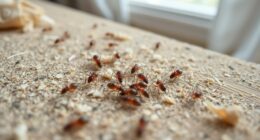If your catmint is turning brown, it’s likely due to environmental stress, over- or underwatering, or poor placement. Make sure you’re watering consistently, allowing the soil to dry slightly between waterings, and provide at least six hours of sunlight daily. Check for pests or disease, and avoid handling the plant roughly. Adjusting watering, improving airflow, and ensuring the right light and humidity can help. Keep exploring for more tips to restore your catmint’s health.
Key Takeaways
- Overwatering or underwatering can cause root stress, leading to browning; maintain consistent soil moisture.
- Insufficient sunlight weakens plants, increasing susceptibility to browning and disease.
- Temperature extremes, both cold and heat, damage plant cells and cause browning; stabilize environmental conditions.
- High humidity fosters fungal issues, while low humidity causes moisture loss and browning edges.
- Proper pruning, pest control, and soil testing support plant health and aid recovery from stress-induced browning.
Overwatering and Underwatering Issues
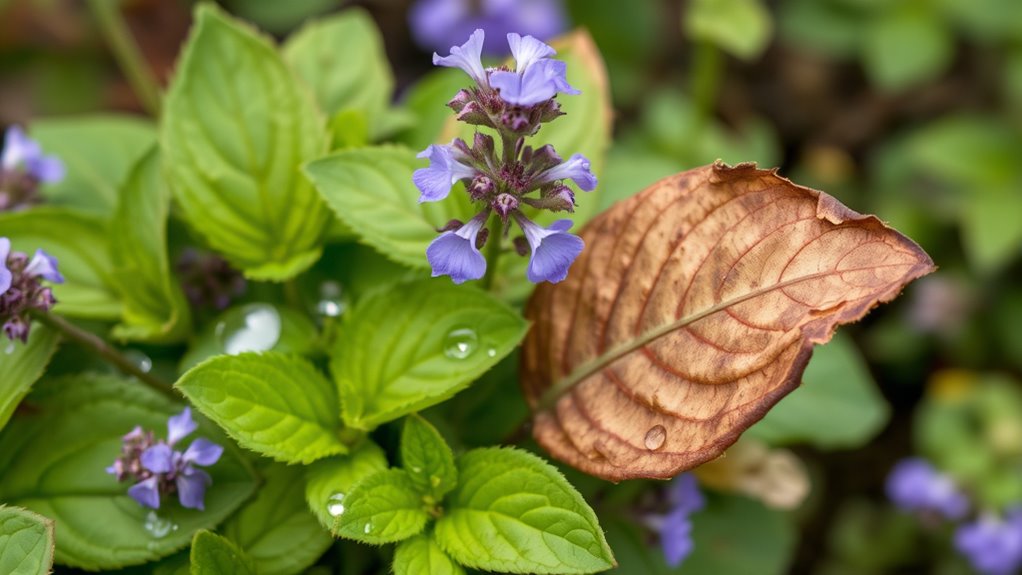
One common reason for catmint turning brown is improper watering, whether you’re overwatering or underwatering. Overwatering can cause root rot, weakening the plant’s roots and leading to browning leaves. When roots decay, the plant can’t absorb nutrients properly, making it look unhealthy. Conversely, underwatering stresses the plant, causing leaves to dry out and turn brown. Consistent watering helps keep the soil moist but not soggy. To prevent issues, check soil moisture regularly and adjust watering habits accordingly. Proper watering also aids pest control, as healthy plants are less vulnerable to pests that often target stressed or weakened foliage. Maintaining a balanced watering routine ensures your catmint stays healthy, vibrant, and free from browning caused by watering errors.
Insufficient Sunlight and Improper Placement
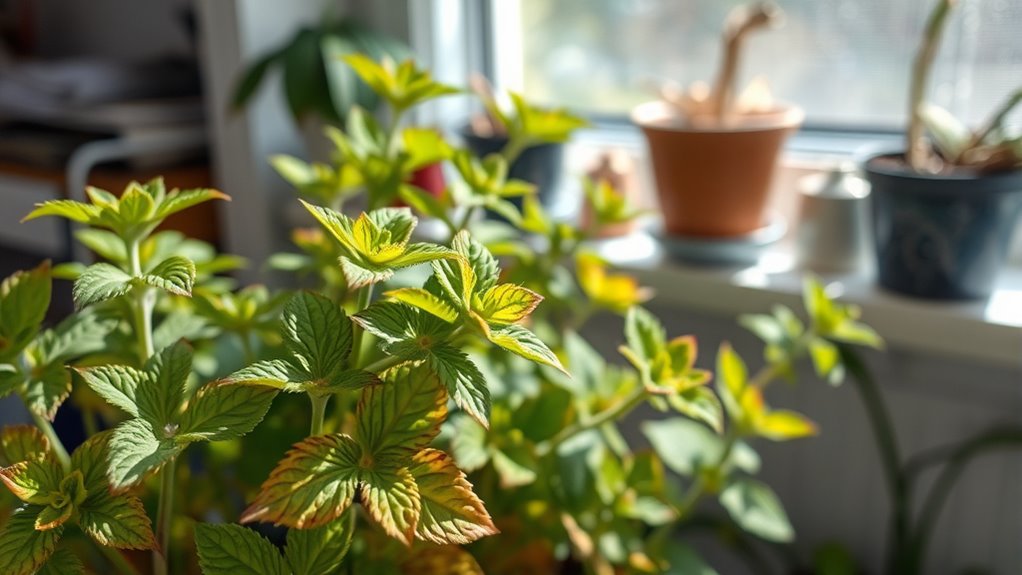
If your catmint is placed in a spot that doesn’t receive enough sunlight, it can start turning brown and losing its liveliness. Sunlight is essential for healthy growth and vibrant foliage. When designing your garden, choose a location with ample direct light, ideally 6 hours or more daily. Improper placement can weaken the plant, making it more vulnerable to stress and pests. Good garden design involves positioning catmint where it can thrive naturally, reducing the need for interventions. Additionally, proper placement helps with pest prevention, as healthy plants are better at resisting infestations. If your catmint isn’t getting enough sun, consider relocating it to a sunnier spot to promote vigorous growth and maintain its lush, green appearance. Ensuring adequate sunlight exposure encourages healthy plant growth and resilience. Proper placement also supports the plant’s ability to resist disease and pests, contributing to its overall health and vitality.
Pest Infestations and Disease Problems
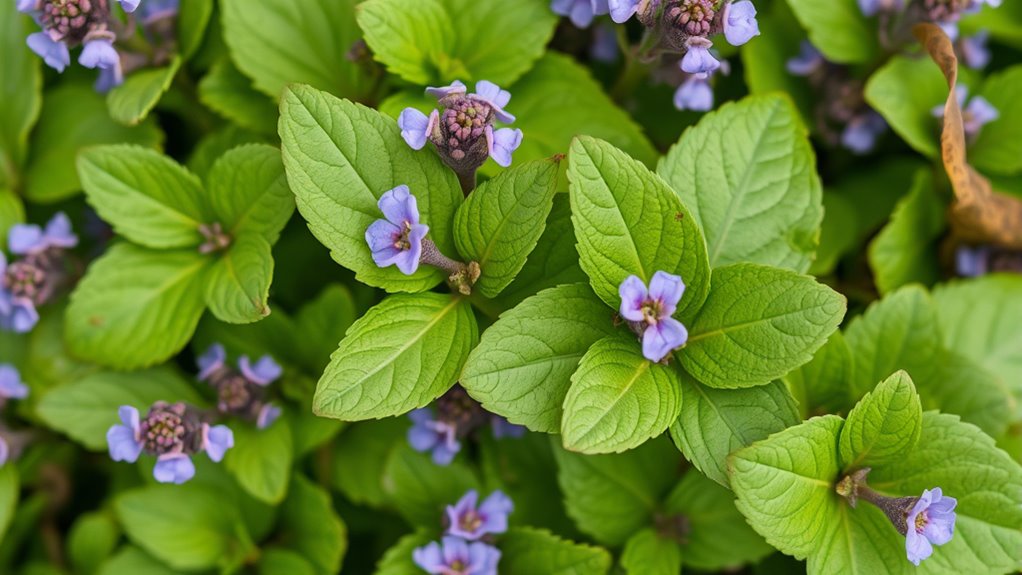
When catmint isn’t getting enough sunlight, its health weakens, making it more susceptible to pests and diseases. To protect your plant, focus on effective pest control by regularly inspecting for aphids, spider mites, or whiteflies. Use natural remedies or insecticidal soap to eliminate infestations early. Good airflow and proper spacing help prevent fungal diseases like powdery mildew or root rot. Avoid overwatering, which can promote disease development. Remove any affected leaves promptly to stop the spread. Keeping your catmint healthy with consistent pest control and disease prevention measures is essential for maintaining its vibrant color and growth. Additionally, maintaining optimal growing conditions is crucial for overall plant health and resilience. Proper watering practices and ensuring adequate sunlight can significantly reduce stressors that cause browning. Addressing problems early guarantees your plant stays resilient and less prone to browning caused by pests and diseases. Regular monitoring and understanding plant health are key to early detection and effective treatment.
Soil Quality and Nutrient Deficiencies
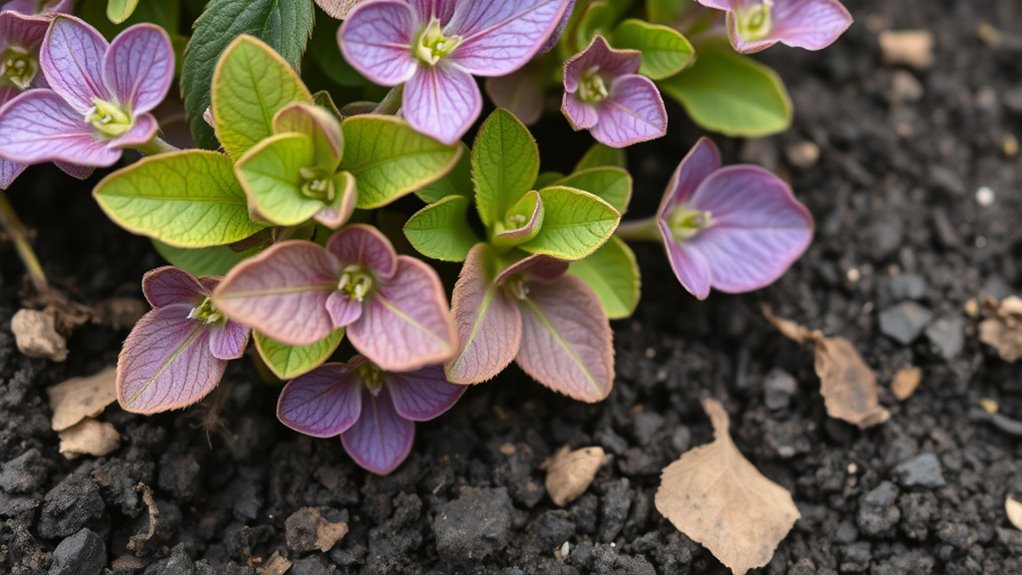
Your catmint’s health depends on balanced soil pH and adequate nutrients. Signs like yellowing or browning leaves can indicate deficiencies or pH issues. Improving soil fertility with proper amendments can help your plant thrive again. Practicing mindful gardening practices can also prevent future stressors and promote healthier growth. Additionally, understanding soil quality and nutrient management can optimize plant health and resilience. Using proper soil amendments can further enhance nutrient availability and support vigorous growth.
Soil Ph Imbalances
Soil pH imbalances can substantially affect the health of your catmint by disrupting nutrient availability. If the soil is too acidic or alkaline, your plant may struggle to absorb essential nutrients, leading to browning and poor growth. To address this, start with soil testing to determine the current pH level. Once you know the pH, you can perform pH adjustment by adding lime to raise alkalinity or sulfur to lower acidity. Regular pH monitoring ensures your catmint’s soil remains within the ideal range of 6.0 to 7.0. Correcting pH imbalances helps your plant absorb nutrients effectively, promoting lush, healthy foliage and preventing browning caused by nutrient deficiencies linked to improper soil conditions. Additionally, maintaining proper soil drainage and aeration supports healthy root development and overall plant vitality.
Nutrient Deficiency Signs
Nutrient deficiencies often manifest as visible signs on your catmint, indicating that the soil isn’t providing the essential elements the plant needs to thrive. One common sign is leaf discoloration, such as yellowing or paleness, which points to nitrogen deficiency. If you notice reddish or purplish leaves, it could signal phosphorus deficiency. Fertilizer deficiencies can also cause stunted growth or sparse foliage, making the plant appear weak. Sometimes, leaf edges may brown or scorch due to potassium shortages. Recognizing these signs early helps you identify which nutrients are lacking. Addressing fertilizer deficiencies promptly by applying appropriate nutrients can restore your catmint’s health. Keep an eye on leaf color and overall vigor to prevent further stress and support recovery. Ensure proper soil quality and follow recommended fertilization practices to maintain healthy growth. Additionally, regular testing of your soil’s nutrient levels can help you make informed adjustments to your fertilization routine. Incorporating mindful practices like monitoring plant health regularly can also aid in early detection and prevention of deficiencies.
Improving Soil Fertility
Improving soil fertility is essential to guarantee your catmint receives the nutrients it needs to stay healthy and vibrant. Start by adding compost, which enriches the soil with organic matter and essential nutrients. Compost addition not only boosts soil structure but also improves moisture retention and drainage. Incorporate organic amendments like composted manure or plant-based materials to supply a steady release of nutrients. These natural enhancements help correct deficiencies and create a balanced environment for root growth. Avoid synthetic fertilizers, as they can cause rapid nutrient fluctuations. Regularly testing your soil will guide you on specific needs, ensuring you apply the right amendments. By focusing on organic improvements, you’ll foster a healthy, nutrient-rich soil that supports lush, resilient catmint.
Environmental Stress: Temperature and Humidity
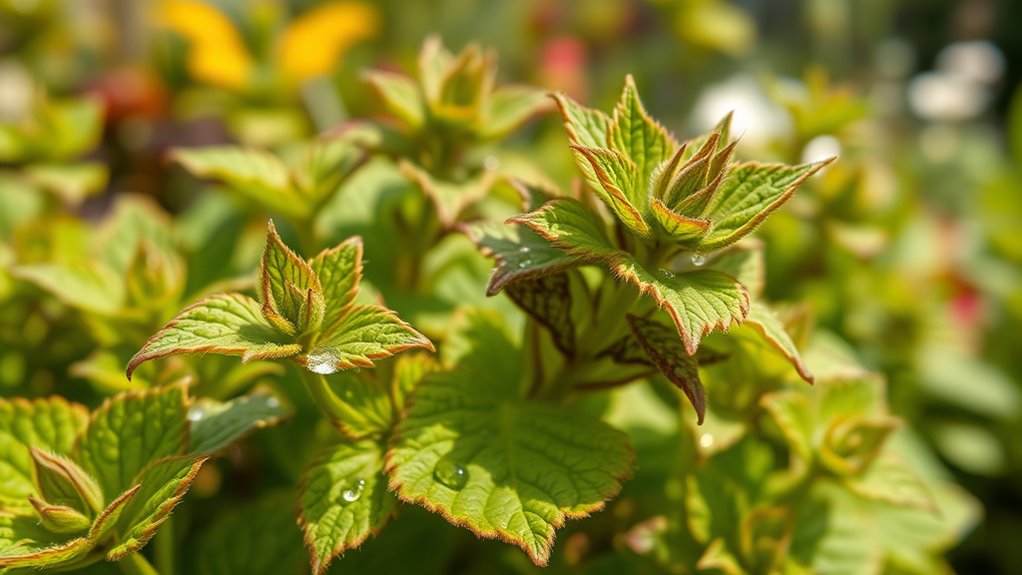
Temperature swings can stress your catmint, causing browning and leaf damage. Humidity levels also play a role, with too much moisture encouraging diseases. To keep your plant healthy, you need to manage these environmental conditions carefully. Proper plant tuning techniques, such as adjusting watering schedules and providing adequate airflow, can further promote healthy growth. Monitoring environmental factors regularly helps prevent stress and supports the plant’s resilience.
Effects of Temperature Fluctuations
When temperature fluctuations occur, your catmint plants can experience significant stress that affects their overall health and appearance. Temperature stress caused by seasonal changes can lead to browning, wilting, or slowed growth. Sudden shifts from warm to cold temperatures disrupt the plant’s internal processes, weakening its defenses against pests and disease. During colder seasons, prolonged exposure to low temperatures can cause cell damage, while excessive heat can cause dehydration and leaf scorch. These fluctuations force your catmint to constantly adapt, which can exhaust its resources. To minimize damage, try to keep temperatures as stable as possible, especially during seasonal transitions. Properly insulating your plant and avoiding drafts can help it better withstand temperature swings and recover more quickly from stress. Additionally, understanding how temperature fluctuations impact plant physiology can guide you in implementing effective protection strategies. Research suggests that stable environmental conditions significantly enhance plant resilience and recovery. Recognizing the role of sound vibrations in plant health, such as through gentle sound therapy, may also support recovery processes.
Humidity Level Impact
Humidity levels play a crucial role in the health of your catmint plants, especially when combined with temperature fluctuations. If the humidity is too high, excess moisture can encourage fungal growth and cause the leaves to turn brown or develop spots. Conversely, low humidity can lead to rapid moisture loss, resulting in wilting and browning edges. Proper moisture control is essential to prevent stress and maintain vibrant, healthy foliage. You should monitor the humidity level impact regularly and adjust watering practices accordingly. Using well-draining soil and ensuring good air circulation helps regulate moisture levels. Maintaining ideal humidity also involves understanding how environmental factors influence plant health, allowing for better adjustments. Additionally, implementing automation tools can help in maintaining consistent humidity levels, reducing stress on your plants. By maintaining ideal humidity, you reduce the risk of browning caused by environmental stress, supporting your catmint’s overall resilience and beauty.
Managing Environmental Conditions
Managing environmental conditions is vital to prevent stress that can cause your catmint to turn brown. Ensure your plant gets the right amount of light exposure—bright, indirect sunlight is ideal. Too much direct sun can scorch the leaves, while too little light can weaken the plant. Maintaining a consistent watering schedule is also crucial; water when the top inch of soil feels dry, avoiding overwatering or drought stress. Proper temperature and humidity levels support healthy growth, so keep your catmint in a space with moderate temperatures and avoid drafts or extreme heat. Adjust lighting and watering habits as needed, especially during seasonal changes. By managing these environmental factors, you help your catmint stay vibrant and resilient, reducing the risk of browning caused by stress.
Damage From Physical Factors and Handling
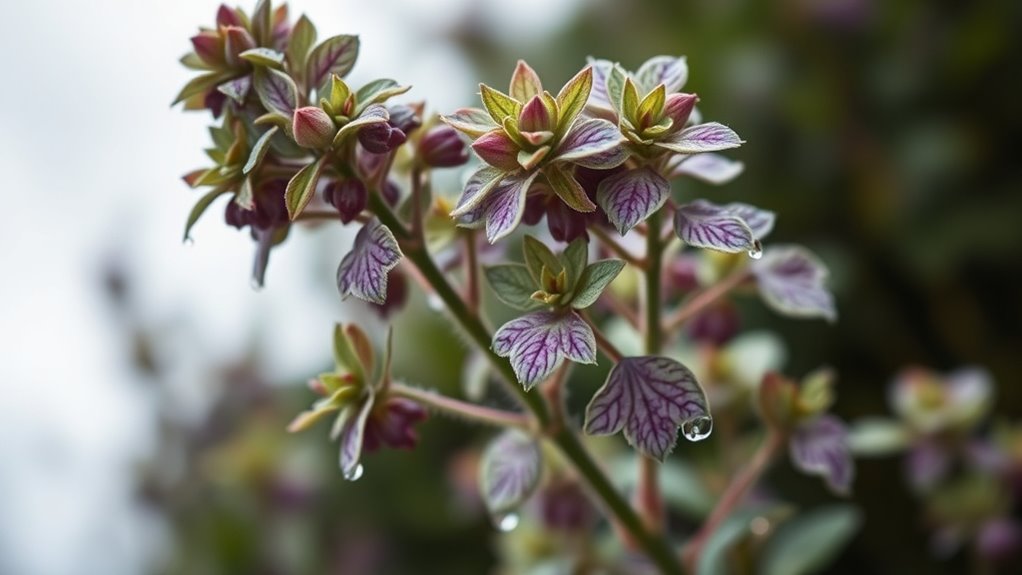
Physical factors and handling can considerably harm catmint, causing the leaves to turn brown and the plant to weaken. Rough handling or improper pruning techniques can stress the plant, making it more vulnerable to damage. To prevent this, follow these handling precautions:
- Use gentle, supportive movements when transplanting or pruning.
- Avoid pulling or tugging on stems to prevent breakage.
- Prune carefully, removing dead or overgrown parts without cutting into healthy tissue.
- Limit disturbance during flowering to reduce stress and promote recovery.
Preventative Measures and Care Tips
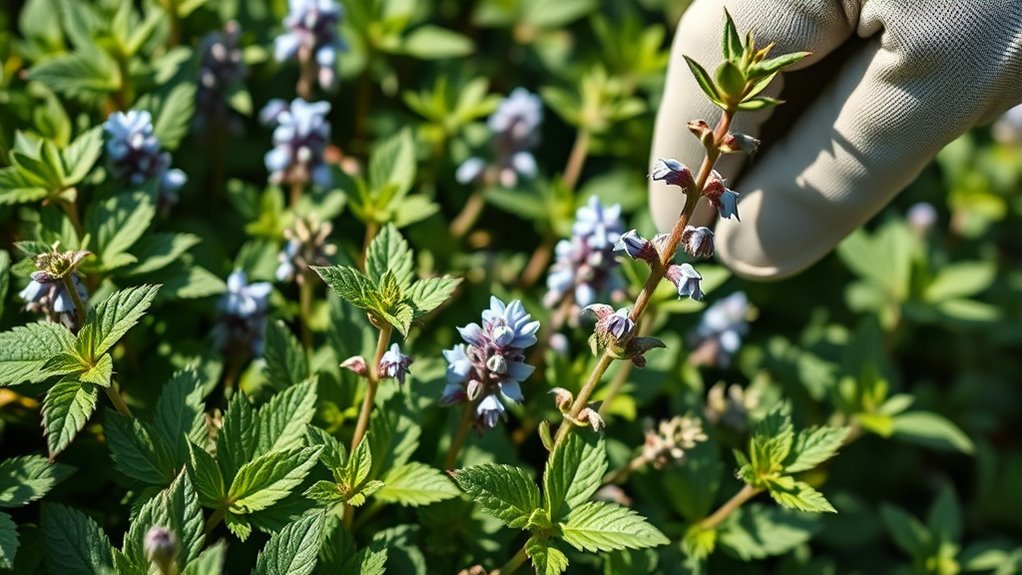
To keep your catmint healthy and prevent browning, implement simple care routines and proactive measures. Start by establishing a consistent watering schedule; avoid overwatering or letting the soil dry out completely. Proper watering helps maintain root health and prevents stress. Use pruning techniques to remove dead or damaged stems regularly, encouraging new growth and airflow. Pruning also prevents the plant from becoming leggy or overcrowded, which can lead to browning. Keep an eye on environmental conditions, such as excessive heat or cold, and provide shade or protection when needed. Mulching around the base helps retain soil moisture and regulate temperature. By following these care tips, you promote a vibrant, resilient catmint and reduce the risk of browning caused by neglect or stress.
Frequently Asked Questions
How Long Does It Take for Catmint to Recover After Browning?
It typically takes a few weeks for your catmint to recover after browning if you adjust watering and sunlight. Make sure you’re watering appropriately—neither overwatering nor underwatering—and give it enough sunlight exposure, ideally 6 hours daily. Keep an eye on the plant’s health, trim any dead parts, and be patient. With consistent care, your catmint should regain its vibrant color and vitality within a few weeks.
Can Pruning Help Reverse Browning in Catmint?
Pruning can definitely help reverse browning in your catmint. By removing the affected stems, you promote new growth and improve airflow, which benefits the plant’s resilience. Pruning benefits include encouraging healthy development and reducing stress on the plant. Regularly trimming your catmint helps it recover faster, keeps it vigorous, and enhances its overall appearance. Just be gentle and avoid over-pruning to ensure *best* recovery and continued health.
Are Certain Catmint Varieties More Resistant to Stress?
They say, “know your enemy,” and that’s true for catmint varieties. Some plant varieties boast higher disease resistance, making them more resilient to stressors like browning. Choosing a variety with robust disease resistance can help your catmint stay healthy longer. While no plant is completely stress-proof, selecting the right variety gives you a better chance of preventing browning and ensuring your garden thrives.
Does Using Fertilizer Speed up Browning Recovery?
Using fertilizer can impact your catmint’s browning recovery by stimulating plant growth. Fertilizer provides essential nutrients that encourage healthy new leaves and overall vigor, helping the plant bounce back faster. However, avoid over-fertilizing, as it can stress the plant further. Proper, balanced fertilization supports recovery without causing additional stress, making it a useful tool to speed up the browning process and promote healthier, greener foliage.
When Should I Consider Replacing My Stressed Catmint Plant?
Think of your plant as a patient in need of care. If stress indicators like wilting, discoloration, or new brown patches persist after trying recovery tips, it’s time for plant replacement. Don’t wait too long—stressed plants won’t bounce back forever. When recovery efforts fail and health declines, replacing your catmint guarantees a healthier start. Trust your instincts; if the plant’s condition worsens, it’s time for a fresh beginning.
Conclusion
So, next time your catmint turns brown, don’t panic—just blame it on the garden gods or your questionable plant-parent skills. With a little attention and some common sense, you’ll have that green thumb back in no time. Remember, even plants need a break from your overzealous watering or accidental trampling. Keep an eye on sunlight, pests, and soil, and soon your catmint will be thriving, proving that you’re not completely hopeless at this gardening thing.



